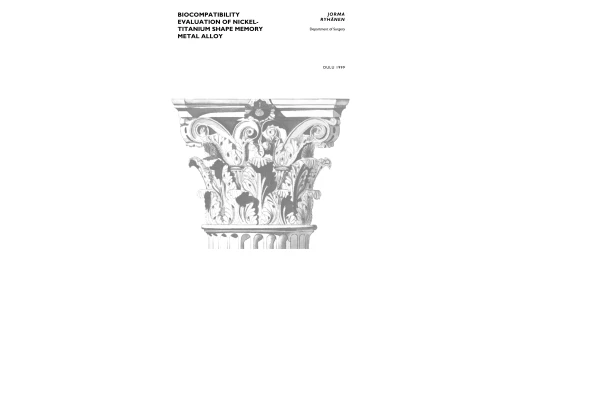
The shape memory effect, superelasticity, and good damping properties, uncommon in other implant
alloys, make the nickel-titanium shape memory metal alloy (Nitinol or NiTi) a fascinating material
for surgical applications. It provides a possibility to make self-locking, self-expanding and selfcompressing implants. The purpose of this work was to determine if NiTi is a safe material for
surgical implant applications.
The primary cytotoxicity and the corrosion rate of NiTi were assessed in human osteoblast and
fibroblast cell cultures. Comparisons were made with 316 LVM stainless steel (StSt) and pure
titanium. The metal ions present in the media were analyzed using atomic absorption spectrometry
(GFAAS). Despite the higher initial nickel dissolution, NiTi induced no toxic effects, decrease in
cell proliferation or inhibition in the growth of cells in contact with the metal surface.
The general soft tissue responses to NiTi were compared to corresponding responses to StSt and Ti-
6Al-4V alloy in rats during a follow-up of 26 weeks. The muscular tissue response to NiTi was
clearly non-toxic and non-irritating, as were also the neural and perineural responses. The overall
inflammatory response and the presence of immune cells, macrophages and foreign body giant cells
were similar compared to the other test materials. At 8 weeks, histomorphometry showed that the
encapsule membrane of NiTi was thicker than that of stainless steel, but at 26 weeks the membrane
thicknesses were equal.
A regional acceleratory phenomenon (RAP) model was used to evaluate new bone formation, bone
resorption and bone (re)modeling after periosteal implantation of NiTi, StSt or Ti-6Al-4V in rats
using histomorphometry. Maximum new woven bone formation started earlier in the Ti-6Al-4V
group than in the NiTi group, but also decreased earlier, and at 8 weeks the NiTi and StSt groups had
greater cortical bone width. Later, no statistical differences were seen. NiTi had no negative effect
on total new bone formation or normal RAP during a 26-week follow-up.
The ultrastructural features of cell-NiTi adhesion were analyzed with scanning electron microscopy
(FESEM). Cell adhesion and focal contacts showed a good acceptance of NiTi.
Femoral osteotomies of rats were fixed with either NiTi or StSt intramedullary nails. Bone healing
was examined with radiographs, peripheral quantitative computed tomography (pQCT) and
histologically. The maximum follow-up was 60 weeks. There were more healed bone unions in the
NiTi than the StSt group at early time points. Callus size and bone mineral density did not differ
between the NiTi and StSt groups. Mineral density in both groups was lower in the osteotomy area
than in the other areas along the nail. Density in the nail area was lower than in the proximal part of
the operated femur or the contralateral femur. Bone contact to NiTi was close, indicating good tissue
tolerance. Determination of trace metals from several organs was done by GFAAS or inductively
coupled plasma-atomic emission spectrometry (ICP-AES). There were no statistically significant
differences in nickel concentration between the NiTi and StSt groups in distant organs. The FESEM
assessment showed surface corrosion changes to be more evident in the StSt implants.
On the basis of this study, the biocompatibility of NiTi seems to be similar to or better than that of
stainless steel or Ti-6Al-4V alloy. NiTi appears to be suitable for further use as a biomaterial,
because its biocompatibility is good. When NiTi is intended to be used in long-term implants, optimal
surface treatment must consider.
دیدگاه خود را ثبت کنید